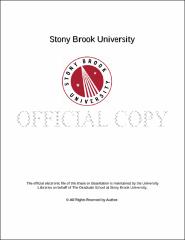| dc.identifier.uri | http://hdl.handle.net/11401/77653 | |
| dc.description.sponsorship | This work is sponsored by the Stony Brook University Graduate School in compliance with the requirements for completion of degree. | en_US |
| dc.format | Monograph | |
| dc.format.medium | Electronic Resource | en_US |
| dc.language.iso | en_US | |
| dc.publisher | The Graduate School, Stony Brook University: Stony Brook, NY. | |
| dc.type | Dissertation | |
| dcterms.abstract | Submarine groundwater discharge (SGD) encompasses all fluids crossing the sediment/ocean interface, regardless of their origin, composition or driving forces. SGD provides a pathway for terrestrial contaminants that can significantly impact coastal ecosystems. Overexploitation of groundwater resources can decrease SGD which favors seawater intrusion at depth. Understanding SGD is therefore crucial for water quality and resource management. Quantifying SGD is challenging due to its diffuse and heterogeneous nature, in addition to significant spatio-temporal variations at multiple scales. In this thesis, an integrated approach combining electrical resistivity (ER) surveys, conductivity and temperature point measurements, seepage rates using manual and ultrasonic seepage meters, and pore fluid salinities was used to characterize SGD spatio-temporal variations and their implications for contaminant transport at several locations on Long Island, NY. The influence of surficial sediments on SGD distribution was investigated in Stony Brook Harbor. A low-permeability mud layer, actively depositing in the harbor, limits SGD at the shoreline, prevents mixing with seawater and channels a significant volume of freshwater offshore. SGD measured at locations without mud is high and indicates significant mixing between porewater and seawater. A 2D steady-state density-difference numerical model of the harbor was developed using SEAWAT and was validated by our field observations. Temporal variations of SGD due to semi-diurnal tidal forcing were studied in West Neck Bay, Shelter Island, using a 12-hr time-lapse ER survey together with continuous salinity and seepage measurements in the intertidal zone. The observed dynamic patterns of groundwater flux and salinity distribution disagree with published standard transient state numerical models, suggesting the need for developing more specific models of non-homogeneous anisotropic aquifers. SGD distribution and composition were characterized in Forge River, a tidal river that experiences chronic hypoxia due to nitrogen contamination. We found that nitrogen speciation and concentration are linked to different SGD regimes. Near shore sandy zones with high SGD show little nitrate reduction and constitute the major source of nitrogen input to surface waters. Offshore areas rich in silt and organic matter exhibit low SGD and higher denitrification. Dredging activities have altered the sediment distribution and subsequently have created preferential flow paths focusing freshwater discharge into the center of the river. | |
| dcterms.available | 2017-09-20T16:53:12Z | |
| dcterms.contributor | Hanson, Gilbert | en_US |
| dcterms.contributor | Wong, Teng-fong | en_US |
| dcterms.contributor | Davis, Daniel | en_US |
| dcterms.contributor | Bokuniewicz, Henry | en_US |
| dcterms.contributor | Walker, Harold. | en_US |
| dcterms.creator | Durand, Josephine Miryam Kalyanie | |
| dcterms.dateAccepted | 2017-09-20T16:53:12Z | |
| dcterms.dateSubmitted | 2017-09-20T16:53:12Z | |
| dcterms.description | Department of Geosciences. | en_US |
| dcterms.extent | 182 pg. | en_US |
| dcterms.format | Application/PDF | en_US |
| dcterms.format | Monograph | |
| dcterms.identifier | http://hdl.handle.net/11401/77653 | |
| dcterms.issued | 2014-12-01 | |
| dcterms.language | en_US | |
| dcterms.provenance | Made available in DSpace on 2017-09-20T16:53:12Z (GMT). No. of bitstreams: 1
Durand_grad.sunysb_0771E_11999.pdf: 8578055 bytes, checksum: af7cc9a19727b950e4a29f6e00068a71 (MD5)
Previous issue date: 1 | en |
| dcterms.publisher | The Graduate School, Stony Brook University: Stony Brook, NY. | |
| dcterms.subject | Hydrologic sciences | |
| dcterms.subject | Coastal aquifer, Electrical resistivity, Long Island, Seepage measurements, Submarine groundwater discharge | |
| dcterms.title | Characterization of the Spatial and Temporal Variations of Submarine Groundwater Discharge Using Electrical Resistivity and Seepage Measurements | |
| dcterms.type | Dissertation | |

